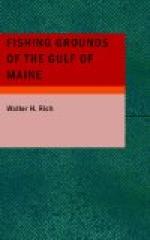The winters are long, usually bringing heavy snowfalls; and strong gales are frequent during much of the fall and winter season. Perhaps the most dangerous of these “blows” come out of the mountain to the north and northwest of the gulf. Thus, in addition to the uncertainty of an opportunity to set gear when once upon the fishing grounds, the winter fishing here is not without its element of serious danger. While the ice crop in northern New England never fails, yet, perhaps because of the strong tidal currents of these waters, the principal harbors rarely are closed by ice, or, if closed, for but a few days only.
While the summers are fairly mild and in certain parts of them even extremely hot, fogs are heavy and virtually continuous during the “dog days” (July 20 to September 1). when southerly and south-westerly breezes bring the warm moist air from the Gulf Stream into the cooler currents from the land. The fogs of Fundy are especially noted, even in these waters. During the summer seasons winds from the east and north bring the only clear weather experienced in the outer chain of fishing grounds.
The main body of the gulf lies approximately between 42 deg. and 45 deg. north latitude. It is in form like a deep bowl whose outer rim is made by Georges Bank and Browns Bank, with a narrow, deep-water spillway between: its area is half encircled in the arms of the mainland, two conspicuous headlands reaching bodily seaward to mark its wide entrance at the opposite sides—Cape Cod, Mass. [7] on the western side, and Cape Sable, [8] Nova Scotia, on the eastern flank, distant from each other about 230 miles. These two capes range with each other about ENE. and WSW, thus matching alike the general trend of the coast line, of the island chains and of the offshore ledges within this area.
From a base line connecting these outposts of the gulf the distance to the Maine coast opposite averages about 120 miles. From Cape Sable, at its eastern end, the coast trends for some distance to the northwest, whence a continuation of this course strikes the coast of Maine near West Quoddy Head at a distance of rather more than 110 miles. From West Quoddy head to Cape Elizabeth (in a direct line about 160 miles) the coast, in general rough, rocky, and with many lofty headlands is extremely irregular and deeply indented and follows a general course of WSW. Thence, the coast, lower and becoming more and more sandy, begins to trend more decidedly south-west until it reaches Boston, when it turns to the southeast, and to the east toward Cape Cod.
But this is not the entire story. There remain outside of these stated limits the Bay of Fundy in the north, with a possible area of 3,000 square miles; and at the south Cape Cod Bay, whose area, with that of the waters west of a perpendicular drawn from the western end of the base line that strikes the land in the vicinity of Portsmouth, N. H. makes an additional section containing close to 1,500 square miles. Within the limits thus inclosed there are, roughly, 30,000 square miles of most productive ground most intensively fished through all the year.




